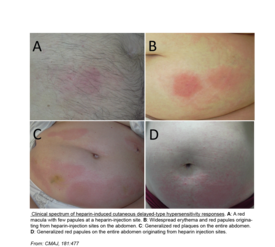Type IV allergic reactions to heparins
We are conducting epidemiological research on heparin-induced, cutaneous adverese reaactions to heparin. In this context, the following main findings were made:
- A low incidence of heparin-induced skin lesions in orthopedic surgery patients, Clin Exp Allergy. 2018
- Nadroparin carries a potentially high risk of inducing cutaneous delayed-type hypersensitivity responses, Contact Dermatitis. 2017
- A case report of tolerance of fondaparinux in immediate-type hypersensitivity to heparins, Am J Med. 2015
- High incidence of heparin-induced allergic delayed-type hypersensitivity reactions in pregnancy, J Allergy Clin Immunol. 2013
- Application, tolerance and safety of fondaparinux therapy in a German hospital: a prospective single-centre experience, Thromb Res. 2012
- The risk for cross-reactions after a cutaneous delayed-type hypersensitivity reaction to heparin preparations is independent of their molecular weight: a systematic review, Contact Dermatitis. 2011
- Low allergenic potential with fondaparinux: results of a prospective investigation (PDF), Mayo Clin Proc. 2010
- Heparin-induced non-necrotizing skin lesions: rarely associated with heparin-induced thrombocytopenia (PDF), J Thromb Haemost. 2010
- Incidence and causes of heparin-induced skin lesions (PDF), CMAJ. 2009
- Tolerance of fondaparinux in patients with generalized contact dermatitis to heparin, J Eur Acad Dermatol Venereol. 2008
- Molecular weight determines the frequency of delayed type hypersensitivity reactions to heparin and synthetic oligosaccharides, Thromb Haemost. 2005
Note: The findings herein were based on a too small sample size and were prooven incorrect in later studies by others and us!
- Intolerance of fondaparinux in a patient allergic to heparins, Contact Dermatitis. 2004
- Tolerance of fondaparinux in a patient allergic to heparins and other glycosaminoglycans, Contact Dermatitis. 2003
These findings are reviewed in:
- Heparin-induced skin lesions, Lancet. 2012
- Therapeutic use of heparin beyond anticoagulation, Curr Drug Discov Technol. 2009
- Management of cutaneous type IV hypersensitivity reactions induced by heparin, Thromb Haemost. 2006
- Structural requirements of heparin and related molecules to exert a multitude of anti-inflammatory activities, Mini Rev Med Chem. 2006
Please contact us, if you need a reprint of any of the above articles (if not downloadable).



